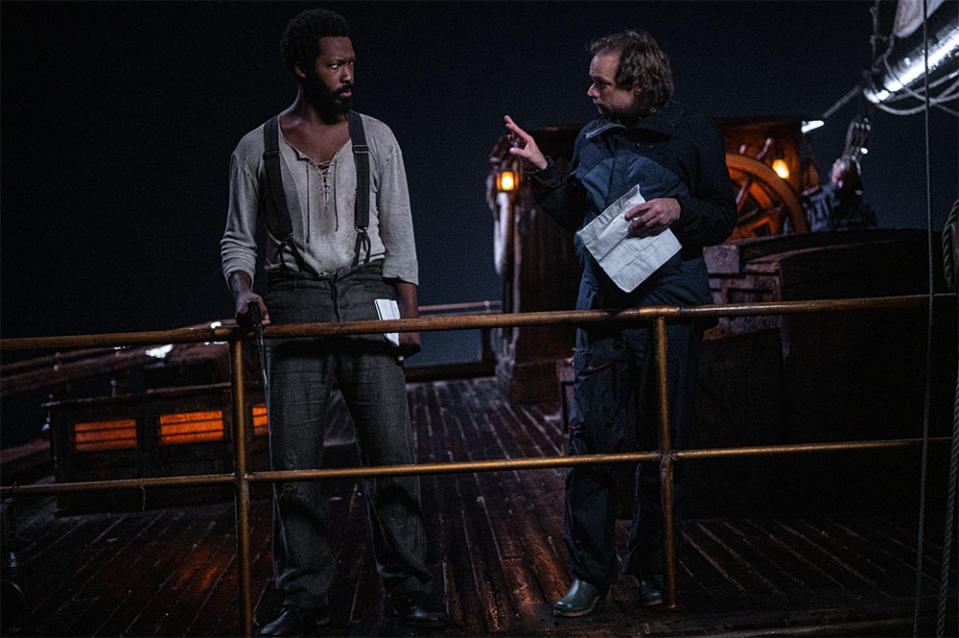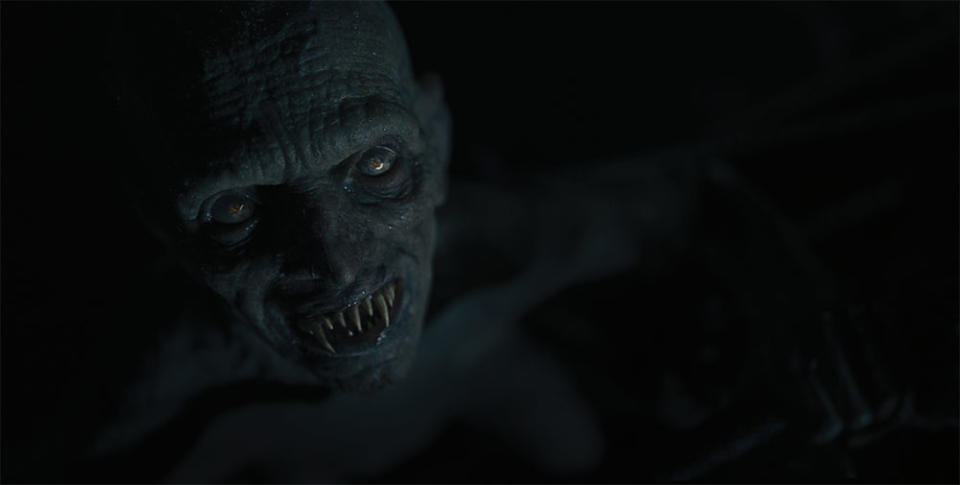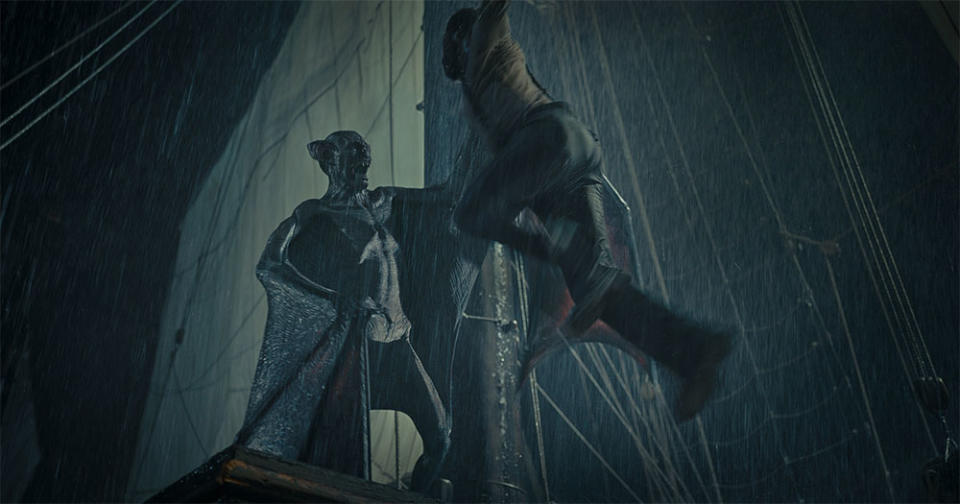‘The Last Voyage of the Demeter’ Director André Øvredal Received Guillermo del Toro’s Blessing

André Øvredal’s The Last Voyage of the Demeter may be based on one chapter of Bram Stoker’s Dracula, but the film has had many chapters in its 25-year development saga.
Co-screenwriter Bragi Schut Jr.’s original script dates back to the late ‘90s, as he felt that Stoker’s “The Captain’s Log” chapter could warrant the Alien-on-a-merchant-ship treatment, with Dracula taking the place of a Xenomorph. In the two-plus decades that followed, creative teams changed several times, and names like David Slade, Neil Marshall, Jude Law, Noomi Rapace, Ben Kingsley and Viggo Mortensen came and went.
More from The Hollywood Reporter
How 'Guillermo del Toro's Cabinet of Curiosities' Makeup Pros Made Curious and Chilling Creatures
Guillermo del Toro's 'Frankenstein' Eyes Oscar Isaac, Andrew Garfield and Mia Goth
Guillermo del Toro was also once attached to the project, and when his schedule became an issue, he quickly recommended Øvredal as his replacement. Del Toro had just produced Øvredal’s Scary Stories to Tell in the Dark (2019), so the two filmmakers had some early discussions about the project before setting sail.
“I had great conversations with him at the beginning, before we got off the ground, and they were extremely helpful,” Øvredal tells The Hollywood Reporter. “I learned so much from working with him on Scary Stories to Tell in the Dark that I was already inside his mind to the degree that I can be.”
Javier Botet, one of the world’s preeminent creature performers, also worked with Øvredal and del Toro on Scary Stories, and he took on the storied role of Dracula in Demeter. Øvredal kept Woody Norman’s young character separated from Botet’s character in order to capture the former’s real surprise during a dramatic scene in the film. Norman, who was already coming off of another disturbing movie in Cobweb, very much wanted the immersive experience.
“Woody hadn’t seen him yet, so we started recording to get his first reaction as Javier came in from the darkness. And he really had a wonderful reaction,” Øvredal says. “You can tell from his eyes that he’s seeing something that he had never seen before, so that was very deliberate.”
Below, during a recent chat with THR, Øvredal also discusses how a potential sequel would have to differ from the source material.
So The Last Voyage of the Demeter has been in development for quite a while. The first draft was written 25 years ago, and it’s been through many hands since then. How did you finally get it into production?
Well, I’m not gonna take any credit for that. I was just a lucky director who happened to be there when the producers and the studio got it into production. They have obviously worked with several super-talented filmmakers over the years, and I was just glad that everything finally came together. Every movie is a miracle to get off the ground, especially a movie like this. It’s set on a ship, it’s a period piece, it needs the right financing structure and it needs the right people behind it on every level. So it just happened to be on my watch, and I’m very lucky.

With so many different drafts of the script, did you just focus on the most recent one?
I was sent a draft that was more or less the latest one. It was the one that Amblin had optioned. And later, when I started talking with Bragi [Schut Jr.], the original writer, he sent me a very early draft from his childhood. (Laughs.) So that was great to read, and it had a lot of the same things. So, even though the script has evolved, it still retained his original vision throughout the process. And even with the draft that [co-writer] Zak Olkewicz wrote while I was working on it with him, it’s still the same story even after that draft.
But he did change a bunch of elements and aspects that I’m proud of, as both the Anna [Aisling Franciosi] and Clemens [Corey Hawkins] characters evolved. I also had Brad Fischer, my brilliant producer, who loves this movie. He knows every draft inside and out, and he would say, “I have a draft from some years ago that had a scene … ” So we would discuss some detail that resembles another idea, and then we would look at that. But it was mostly based on the Amblin draft and the one that we made on our own.
Before you saw the script, were you skeptical that a 33-page chapter from Bram Stoker’s Dracula could be enough to furnish a two-hour feature film?
Not really. You have the characters, you have the setting, you have Dracula and you have the time to introduce this crew. There’s a lot of stuff to mine, and you want to build the dread and the tension slowly through the movie, as everything starts creeping up on the crew. So there’s definitely a lot of material there, and it was an exciting read. It was one wonderful set piece after another, and the characters were really affecting. So I never really thought of it that way.
Your movie is contained to a ship and each character loses their mind a little bit. Did your cast and crew also feel a bit of cabin fever in such a contained environment for 18 hours a day?
(Laughs.) Absolutely, but thankfully, we didn’t work for 18 hours a day. We were trying to keep it civil. But you do get a sense of cabin fever when you’re in the cargo hold for the seventh day in a row, shooting whatever scene. As you shoot a movie completely out of sequence, you do get cabin fever to a degree, for sure. But it wasn’t worse than any other shoot I’ve ever been on. Also, on deck, when we were shooting in Malta, it’s open space. So you become like Dracula, because you are literally standing there on deck and waiting for the sunrise to come and kill your shoot. We were shooting in the middle of the night, and we only had nine or ten hours of night before our day was over. So time is always my greatest fear as a director. So it’s a question of, “Are you able to get the material up to a level of quality that the movie deserves, in the time you have?”
The movie actually takes place during the same time of year that we’re in right now: late July to early August. Did that factor into your release date at all?
It humorously landed there, but that was a date that Universal suggested to us. Early on, we had a January date, but that was just a placeholder. And then we discussed with them where we actually wanted the movie to be, and it became August 11. And it was like, “That’s perfect, because that’s when the story actually happens.” So it’s been fun to see people commenting online about that.
Guillermo del Toro was once attached to some degree, and being a big fan and former collaborator of yours, he recommended you for the job. Did he serve as a sounding board during production or post?
No, unfortunately. He was so busy with two other movies throughout my process with Demeter. He was working on Nightmare Alley at the same time as we were prepping this, and then he was working on Pinocchio. But I had great conversations with him at the beginning, before we got off the ground, and they were extremely helpful. I learned so much from working with him on Scary Stories to Tell in the Dark that I was already inside his mind to the degree that I can be. I learned so much about the precision of storytelling and how to view a movie from top to bottom, and the way he thinks is extraordinary.

Did you separate Javier Botot’s Dracula from the rest of the cast just to create the dynamic that exists for most of the movie?
Somewhat, yeah. We did leave a little bit of surprise. We did it specifically with Woody [Norman] when we were about to shoot their first scene together. It’s when Toby sees Dracula for the first time and when he [spoiler] … (Laughs.) Woody hadn’t seen him yet, so we started recording to get his first reaction as Javier came in from the darkness. And he really had a wonderful reaction. You can tell from his eyes that he’s seeing something that he had never seen before, so that was very deliberate. And it was actually something that Woody really wanted. He didn’t want to see him before we actually shot the scene, and it was a great game.
With so many different versions of Dracula, how did you decide on the look of your iteration?
I definitely wanted the look of an old man who’s gone through so much murder and mayhem and God-awful stuff for hundreds of years. I just felt that it was a more intriguing, textured, layered version of Dracula. We were never going to see him walk around and talk to other characters, like Jonathan Harker. We were never gonna see him in a normal environment. We knew we would slowly build him from basically nothing, with just behavior and images alone. And to portray him as being completely emaciated from not getting the blood he needs to live, and then having to come up on deck and start to take out the crew to survive, I just thought it was a refreshing take on the Dracula mythology and presentation. I was fascinated by it in the script, and so I leaned into it with my direction. And eventually, he evolves and becomes his empowered self again. He gets more and more playful in a way, as he gets more in control, and he can allow himself to become the demonic presence that he really is and that everybody fears on board.
The movie ends in a place where people are going to want to see what happens next, especially since there’s a variation from the book. Have you talked at all about what the next chapter would be?
Yeah, we’ve been humorously discussing whether this movie can keep going. Our title, The Last Voyage of the Demeter, obviously kind of ends it, but the whole idea was to be as truthful to the original source material as possible and still create our own story. But if you wanted to do a sequel, you would actually have to do a revisionist tale, because what happens at the end of the movie does not entirely match up with the book. So you’d have to go a completely different route, and that would be intriguing. So if you were making a sequel, you would probably want to follow the basic trajectory of the book, while adding in some new elements.
I also noticed you thanked Radiohead’s Thom Yorke in the credits. Did he contribute in some way, shape or form?
He just consulted briefly on the score and the soundscape, but that was it, really.

Decades from now, when you’re reminiscing about the making of The Last Voyage of the Demeter, what day will you likely recall first?
I’ll remember when we were standing on deck with these enormous lights and rain towers and water cannons and waves and Javier in a special makeup suit, and the sun started to come up, knowing that we had minutes left to shoot all this stuff. Those are the moments that get stuck in your mind.
***
The Last Voyage of the Demeter is now playing in movie theaters. This interview was edited for length and clarity.
Best of The Hollywood Reporter

 Yahoo News
Yahoo News 
